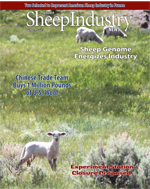
- July 2014
- President’s Notes
- Market Report
- ASI 150th Anniversary Blankets & Pillows Now Available
- Sheep Genome Excites Industry
- Closure of Sheep Experiment Station Proposed
- Industry News Briefs
- Support For Wildlife Services Moves Forward as Appropriations Vote Nears
- Chinese Buyers Get U.S. Wool Close-Up
- ASI Sending Pair of Young Shepherds to France to Compete in 2nd World Ovinpiades
- ASI Photo Contest Seeks Your Best Shots
Sheep Genome Excites Industry
A large international team of researchers has completed the sequence of the sheep genome as part of a study entitled, “The Sheep Genome Illuminates Biology of the Rumen and Lipid Metabolism.”
The work will accelerate research on all kinds of sheep traits – from reproduction and lamb growth to wool quality, milk yield, methane production and disease resistance. These applications will lead to better breeding strategies and new approaches to sheep management.
“The release of the sheep genome assembly is the culmination of a very large international effort,” acknowledges Noelle Cockett, Ph.D., Provost of Utah State University (USU) and Professor in the Department of Animal, Dairy and Veterinary Sciences at USU. “I appreciate the American Sheep Industry’s support of the project and of my involvement throughout the years. The assembly would not have been possible without the encouragement and engagement of the U.S. sheep producers.”
The U.S. components of the project were undertaken at USU, Baylor College of Medicine, U.S. Department of Agriculture’s Agricultural Research Service and Washington State University.
Specific findings include the DNA sequence of sheep, the locations of the genes and an extensive index showing where in the body each of the genes is active. In the past, researchers studying particular traits had to do extensive DNA sequencing – often over months and years – to understand just a few genes at a time. Now the complete set is available in seconds.
“Given the importance of wool production, we looked to see what genes were likely to be involved,” said lead researcher Brian Dalrymple, Ph.D., from the Commonwealth Scientific and Industrial Research Organization (CSIRO). “This identified a novel pathway for the metabolism of lipid in sheep skin, which may play a role in both the development of wool and in the efficient production of wool grease (lanolin).”
Another key finding from the study involved the rumen, which is an essential organ for sheep to convert plant forage into animal protein. Sheep and some other livestock species have a rumen as well as a stomach to help with forage digestion. A number of novel genes have been identified that are only active in the rumen. Finding these genes is the first step toward a better understanding of how sheep process forage so efficiently.
“In my opinion, this is scientific collaboration at its best,” said Clint Krebs, president of the American Sheep Industry Association. “Our industry is very proud of their hard work and especially of the key role U.S. researchers and the leadership of Noelle Cockett played in the process.”

